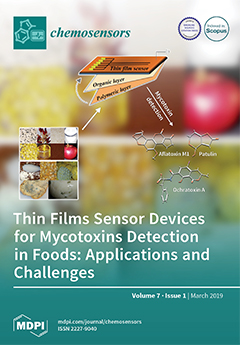Nanostructured materials represent a breakthrough in many fields of application. Above all for sensing, the use of nanostructures with a high surface/volume ratio is strategic to raise the sensitivity towards dangerous environmental gas species. A new Dc-Reactive sputtering Deposition method has been applied
[...] Read more.
Nanostructured materials represent a breakthrough in many fields of application. Above all for sensing, the use of nanostructures with a high surface/volume ratio is strategic to raise the sensitivity towards dangerous environmental gas species. A new Dc-Reactive sputtering Deposition method has been applied to grow highly porous p-type nitrogen-doped titanium oxide layers by modifying the previously developed reactive sputtering method called gig-lox. The doping of the films was achieved at room temperature by progressive incorporation of nitrogen species during the deposition process. Two different amounts of N
2 were introduced into the deposition chamber at flow rates of 2 and 5 standard cubic centimeter per minutes (sccm) for doping. It has been found that the N
2 uptake reduces the deposition rate of the TiO
2 film whilst the porosity and the roughness of the grown layer are not penalized. Despite the low amount of N
2, using 2 sccm of gas resulted in proper doping of the TiO
2 film as revealed by XPS Analyses. In this case, nitrogen atoms are mainly arranged in substitutional positions with respect to the oxygen atoms inside the lattice, and this defines the p-type character of the growing layer. Above this strategic structural modification, the multibranched spongy porosity, peculiar of the gig-lox growth, is still maintained. As proof of concept of the achievements, a sensing device was prepared by combining this modified gig-lox deposition method with state-of-the-art hot-plate technology to monitor the electrical response to ethanol gas species. The sensor exhibited a sensitivity of a factor of ≈2 to 44 ppm of ethanol at ≈200 °C as measured by a rise in the layer resistivity according to the p-type character of the material. At the higher temperature of ≈350 °C, the sensor turned to n-type as without doping. This behavior was related to a loss of nitrogen content inside the film during the annealing. It was indeed proved that p-type doping of a gig-lox sponge during growth is feasible, even at room temperature, without losing the layer porosity and the capability to host and detect environmental species. Moreover, the material integration on a device is simply done as the last production step. Easy TiO
2 doping procedures, combined with porosity, are of general purpose and interest for several applications even on flexible substrates.
Full article





